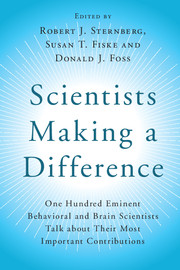 Scientists Making a Difference
Scientists Making a Difference from Section B - Learning and Memory
Published online by Cambridge University Press: 05 August 2016
Intellectual curiosity can take you to unexpected places. Scientists often do not anticipate the future applications of their research. My research into emotional influences on memory is a good example. I did not expect it to deepen our understanding of personal and interpersonal relationships. This essay describes my work in this field as well as that of many others who built on those early findings.
Mood-Dependent Memory Retrieval
In 1979 I became curious about odd effects that psychotropic drugs and multiple-personality disorders have on memory. I wondered if strong emotions could effectively color-code memories that then get stored in separate cerebral storage bins. In other words, do people store memories of what occurs when they are sad in one “compartment,” while relegating into separate storage bins the memories that they form when they are happy, or angry, or frightened, and so on? And, if this is true, could a memory formed when someone felt sad best be retrieved later if the person re-entered a sad emotional state? I called this idea the “mood-dependent retrieval” hypothesis. That basic idea, like a loyal old bird dog, has been retrieving meaty research findings ever since.
In early tests of this hypothesis, my graduate students and I induced college-student volunteers to experience several minutes of happiness or sadness. We did this by asking them to judge the artistry of upbeat or bummer films or music, or by asking them to imagine or recall a happy or sad experience and rate its vividness. Variants of these mood-priming tricks have been used in countless experiments since. Typically, after the mood induction, subjects would be tested on the cognitive task of primary interest to us. This task was usually presented as a separate experiment in order to circumvent subjects consciously enacting the role of a “happy” or “sad” person.
In our first experiment using such mood-inductions, we asked participants to memorize two lists of words. They learned one list in a happy mood and another in a sad mood. Later they were returned to one or the other mood and asked to recall both word lists. Regardless of whether they were happy or sad, participants recalled many more words if the mood in which they first learned the words matched their mood when they recalled them later on.
Mood-dependent retrieval also affected people's ability to recall brief stories or photographic scenes.
To save this book to your Kindle, first ensure [email protected] is added to your Approved Personal Document E-mail List under your Personal Document Settings on the Manage Your Content and Devices page of your Amazon account. Then enter the ‘name’ part of your Kindle email address below. Find out more about saving to your Kindle.
Note you can select to save to either the @free.kindle.com or @kindle.com variations. ‘@free.kindle.com’ emails are free but can only be saved to your device when it is connected to wi-fi. ‘@kindle.com’ emails can be delivered even when you are not connected to wi-fi, but note that service fees apply.
Find out more about the Kindle Personal Document Service.
To save content items to your account, please confirm that you agree to abide by our usage policies. If this is the first time you use this feature, you will be asked to authorise Cambridge Core to connect with your account. Find out more about saving content to Dropbox.
To save content items to your account, please confirm that you agree to abide by our usage policies. If this is the first time you use this feature, you will be asked to authorise Cambridge Core to connect with your account. Find out more about saving content to Google Drive.